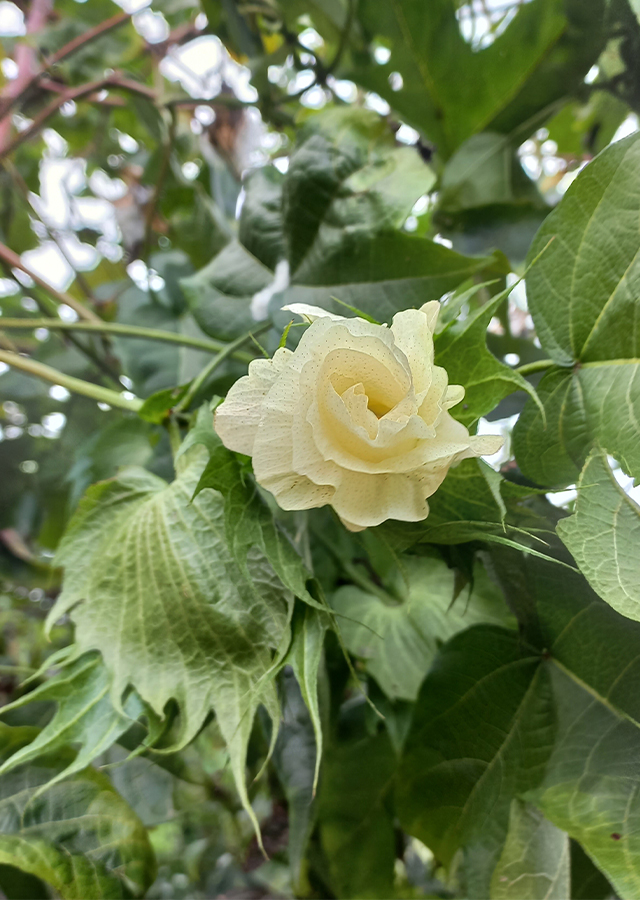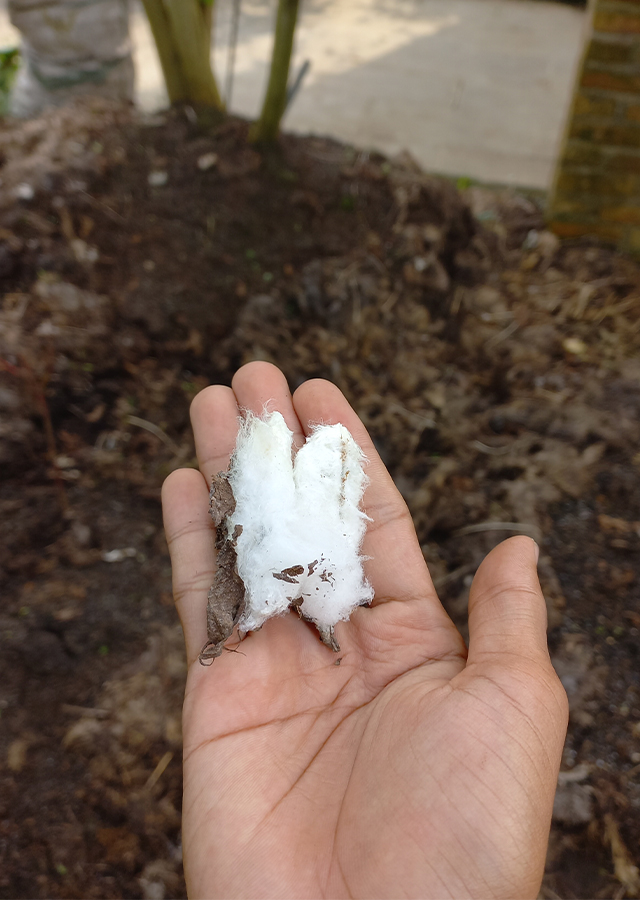Traditional Herbs from Gossypium barbadense
treating_itchy_skin
- Take a stick of Palembang cotton and break it until the sap comes out.
- Apply the sap\u00a0of Palembang cotton directly to the itchy skin.
wound
- Take enough leaves of Palembang cotton\u00a0.", "Wash thoroughly with running water.
- Crush it until it becomes a paste.
- Apply the paste to the injured skin area.
What is Gossypium barbadense Looks like??



Parts of Gossypium barbadense that could be used
- Leaves", "Seeds", "Bark", "Flowers", "Roots
Gossypium barbadense Distribution
Gossypium barbadense probably originated in Peru as a cross between Gossypium herbaceum L. and Gossypium raimondii Ulbrich or Gossypium gossypioides (Ulbrich) Standley. Grows naturally on the coast of Peru and Ecuador. This plant was domesticated in northwestern South America. In Peru cotton products from Gossypium barbadense such as thread, rope, and fishing nets date from around 2500 BC. Cultivation spread across South and Central America and Gossypium barbadense was introduced after 1492 to Africa, Asia and the Pacific Islands. This plant was also introduced to the United States in 1785 where it became known as 'sea island cotton', as opposed to 'upland cotton' (Gossypium hirsutum L.). It is now widely cultivated in warmer parts of the world and is sometimes naturalized. This cotton is the main cotton in Egypt and the West Indies, while other major producers include Sudan, Peru and the United States. In some parts of tropical Africa, for example in Ivory Coast, it has been largely replaced by the more productive Gossypium hirsutum. Cotton is an important oil crop. Gossypium barbadense fiber is highly valued for use in high quality textiles, luxury fabrics, yarn and sewing thread. The oil obtained from Palembang cotton seeds is used industrially in a variety of products, including margarine, mayonnaise, salad and cooking oils, salad sauces and shortening. It is also made into soaps, cosmetics, lubricants, sulfonated oils and protective coatings. Locally it is used for cooking and frying. Gossypium barbadense is sometimes grown as an ornamental plant. Palembang cotton is bee food, providing higher honey yields than Gossypium hirsutum. Gossypium barbadense is also widely used in traditional medicine such as in Africa.�Agroecology of Gossypium barbadense
Palembang cotton can be grown in dry to humid tropical and subtropical areas, where it is found at altitudes of up to 1,500 m above sea level. Commercial production requires a climate that has a long, hot growing season with abundant moisture, followed by a drier period for harvesting seed strings. It grows best in areas where annual daytime temperatures are in the range of 22 - 32 °C, but can tolerate 15 - 38 °C. It prefers average annual rainfall in the range of 750 - 1,250 mm, but tolerates 500 - 1,500 mm. Prefers a very sunny position in light, fertile soil. The plant can tolerate a variety of well-drained soils, including moderate salt levels. Prefers pH in the range of 5.2 - 7.2, tolerates 5 - 8.5. Requires a position protected from strong winds.
Morphology of Gossypium barbadense
- Strong taproot, often with four rows of lateral roots.
- Monopodial main stem with descending segments from base to top; leaf-bearing node with axillary branches.
- Leaves spirally arranged, stipules linear, lanceolate or ovate , on flowering shoots often ovate to ovate and with seeds at the base, 1-5 cm long, leaf stalk half the length of the blade; 3-7 palms with largest central segment, upper leaves sometimes unsegmented, lobes ovate to lanceolate, heart-shaped base, flat margins, 3-9 veined, with 1-3 central leaf veins with elliptical nectar slightly above base at bottom.
- Flowers solitary, usually on sympodial branches. Pedicel shorter than petiole, unarticulated, sharply triangular, usually carries nectar below segment insertion epicalix.\u00a0Epicalyx segments (bracteoles) 3, erect, attached to the crown or fruit, orbicular to ovate, 4\u20136 cm long, heart-shaped at the base and strong auricles, with 5\u201317 pointed teeth, persistent; calyx, 8\u201310 mm long, with 5 short blunt teeth at the truncated apex, densely mottled, carries 3 nectar outside at the base, splits after flowering.\u00a0Corolla usually yellow with dark red or purple spots at the base, calyx 5 , imbricate, obovate, 5\u20138 cm long, truncated and emarginate at the apex.\u00a0Stamens numerous, forming an upright column along the length 2.5\u20134 cm, short filaments, single-celled anthers.\u00a0Pistil with 3-5-celled ovary and one short stalk with stigma, stigma 3-5 sulcate.
- Fruit ('boll') capsule ovoid to fusiform 3.5\u20136 cm long, beaked, glabrous, densely seeded, black, opens loculicidally, 3-celled with several seeds per cell.
- Seeds are ovoid, 8\u201310 mm long, with a sharp hilus, black to dark brown, with a thick covering of long, smooth, white hairs (fibers or threads) and a short, fine tomentum (fuzz) everywhere- mana or only at the hilus or not there.
Cultivation of Gossypium barbadense
Gossypium barbadense is propagated through seeds.
Gossypium barbadense, more details :
Chemical Content of Gossypium barbadenseTriterpenoid and sesquiterpenoid compounds aldehydes, gossypol, hemigossypol, 6-methoxyhemigossypol, 6-deoxyhemigossypol, 6-methoxyhemigossypol, 6, 6'-dimethoxy hemigossypol, heliocides H1 and H2, gossyrubilone, 3, 4-dihydroxy-5-isopropyl-7-methyl -2H – naphtho [1, 8-bc] furan, 3-hydroxy-5-isopropyl-4 -methoxy-7-methyl-2H – naphtho [1, 8-bc] furan, desoxy-6-methoxyhemigossypol, flavonol , tannins, cytotoxic sulfate compounds, sesquiterpene glycosides, sesterpenoids, essential oils (monoterpenes consist of tricyclene, bornyl acetate, pinene, terpinene, isoleden).
Benefits of Gossypium barbadense
Has properties as an abortifacient, emetic, emmenagogue, laxative, treats difficult or irregular menstruation, strengthens the uterus, treats eye diseases, high blood pressure, stomach cramps and pain, diseased ovaries, to treat skin rashes and cramps in children , treating itchy skin, medicine for yaws, as an auricular analgesic, medicine for canker sores, diarrhea, dressing for wounds, treating boils, scabies, leprosy, colds, bronchitis, rheumatism, hemorrhoids, treating dental caries and gingivitis, as a male contraceptive. Has antipruritic, diuretic, hypotensive, antifertility and antiviral activity.
Simplisia of Gossypium barbadense
Another Facts for Gossypium barbadense :
Synonym of Gossypium barbadenseGossypium acuminatum Roxb. ex G.Don, Gossypium auritum O.F.Cook & J.W.Hubb., Gossypium barbadense var. apospermum (Sprague) Roberty
Habitus of Gossypium barbadense
Bush. Annual shrub, up to 3 m high
Habitat of Gossypium barbadense
- Riverside
- Bushland
- Land
No comments:
Post a Comment